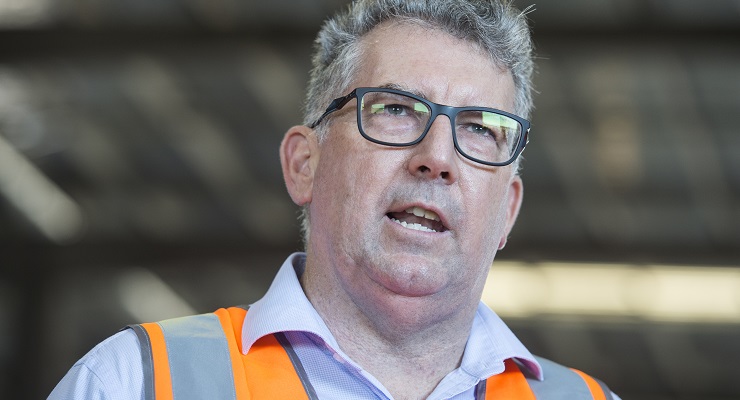
The Coalition’s implosion over climate is continuing apace, with Resources Minister Keith Pitt now calling for a $250 billion loan facility for the mining sector in return for a commitment to net zero by 2050.
The demand, reported “exclusively” in the AFR, is comical — not just because it could guarantee coal production until 2150, but because of its sheer size.
$250 billion is about 12.5% — or one eighth — of Australia’s GDP. It’s four times the amount of money Australia was willing to spend on dud submarines and three times the cost of the NBN.
The loan would not only be in direct contradiction to the government’s own meagre commitments to net zero, it would effectively create a government-backed slush fund for the fossil fuel industry for decades to come.
Liberal MP Jason Falinski has already called it a waste of taxpayer funds.
“The government should not agree to lend money to private companies when the private sector won’t lend them money,” he told RN.
Pitt’s office was unable to tell Crikey how it came up with the $250 billion figure. We asked Nationals leader Barnaby Joyce to explain but he said it was a matter for Pitt. “It is one of the items that will be up for National Party discussion,” he said.
The demand reflects the willingness of the Nats to hold the government to ransom over its climate commitments ahead of global climate talks. It also reflects their rage over an increasingly coal-averse finance sector.
Agriculture Minister David Littleproud has already demanded that the banking system be destabilised by the withdrawal of deposit guarantees for banks that refuse to fund coal projects. And Matt Canavan wants every Australian mortgage holder to pay what would in effect be a coal tax by locking out banks that refuse to invest in coal, thus driving up interest rates.
But what would Keith Pitt’s $250 billion deliver? According to a Reserve Bank (RBA) paper in 2018, the current level of replacement capital expenditure — that is, how much investment is needed to continue to dig up the same amount as currently being produced — is around $10 billion for a five year period for the coal mining and iron ore sectors combined. So Pitt’s quarter-trillion facility would guarantee 125 years of replacement investment in both coal and iron ore on current spending levels. And obviously even longer if it was just for coal.
“There is no global precedent for this,” Tim Buckley, Director Energy Finance Studies at The Institute for Energy Economics and Financial Analysis, told Crikey.
“It’s like the WHO setting up a slush fund for the tobacco industry.”
Of course, you could make Pitt’s facility pay not just for replacement investment but ALL investment — new trucks, new trains, new computers, replacement parts, diesel, new chairs in the boardroom, the lot. That was estimated by the RBA in 2018 to be worth around $50 billion over five years. So $250 billion would get you comfortably to the mid-2040s without any coal company ever having to pay for anything ever again. Presumably, Pitt thinks they should keep the profits though.









It beats me why the Liberal party does not call their bluffs. Say no – what are the Nats going to do – cross the floor to vote on a no confidence motion against the government – and risk losing all their sinecures – I don’t think so. The Nationals get fewer votes than the Greens but effectively run the country for the benefit of the people who are going full steam ahead destroying our planet.
I thought exactly the same when Turnbull became PM – would the Nats rather be out of government than have less than they had demanded?
Yes, I also often advocated, esp after his stunning ‘win’ in 2016.
Had Talcum simply walked into the (Lib) party room the Day After and said “back me or sack me” and threaten a by-election, he would have been all-powerful.
(It was what happened at the end anyway, so why not DO SOMETHING!! first?)
The grifters & carpet baggers would have united against the gNats and we might have had a agile & innovative country.
Instead, we got Porcus Aviatrix.
I think is is time for the Liberals to challenge these monkeys in their own seats. There is nowhere in Australia thatg would not be better for voting its Nationals member out, even if it were one term. Drive through outback Qld and see how good the mobile service is on the main highways, it isn’t great in NSW, but it is bloody awful in Littleproud’s electorate and in fact from Cunnamulla to Winton to Richmond to Charters Towers it is atrocious.
Total blackspot in Werris Creek, Liverpool plains despite having the Whitehaven mine and just north of the holy Hunter salt-of-the-Earth coalminers.
Couldn’t agree more. Oh, for a Liberal leader with enough guts and ethics to tell the Nats where to go. Maybe in the next century…
Smirky does not have the ticker to do something like that
FFS.
Only in Australia, with this government, could an idea so spectacularly stupid gain any traction.
Outrageous demands once again coming from the Nats. So tired of so few holding the country to ransom. It is wrong and unfair in every way that the Nats have so much power. So wrong.
Pitt’s suggestion might be improved slightly by nationalising the entire Australian coal industry instead of just subsidising it. Then the tax payers would actually be getting something for their money.
I’m sure that, with that modest change, the Nats could still find a way of turning it into a money laundering scheme wherein taxpayer dollars are funnelled into their pockets.
British Coal Board=Thatcher.
Is it an ambit claim so ridiculously large that the result will inevitably that the Nats get some level of slush money rather than the zilch that should be paid to their interests for any role in reaching zero emissions by 2050?